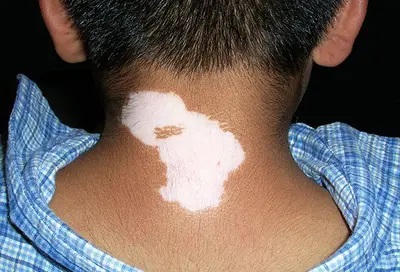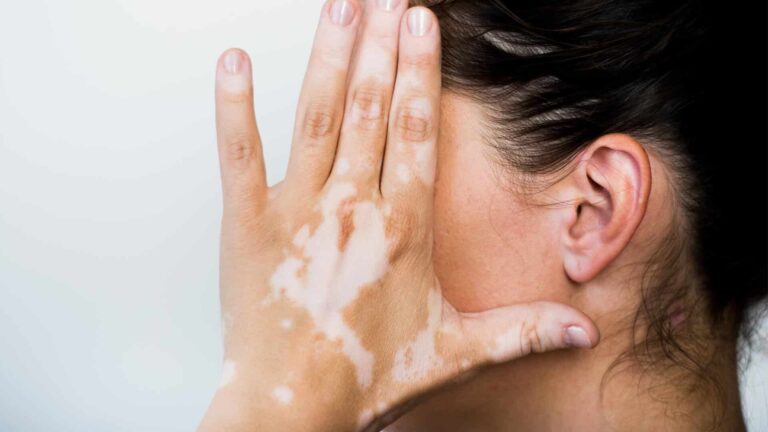What is vitiligo?
Vitiligo is a skin condition where the melanocytes, the cells responsible for producing the pigment melanin, stop functioning properly. This leads to a loss of pigment and the appearance of white or pale patches on the skin.
What causes vitiligo?
The exact cause of vitiligo is not fully known, but several factors are believed to contribute:
- Autoimmune response: The immune system mistakenly attacks and destroys melanocytes.
- Genetic factors: A family history of vitiligo or other autoimmune disorders increases the risk.
- Oxidative stress: A build-up of harmful free radicals may damage pigment cells.
- Neurogenic factors: Nerve endings may release substances toxic to melanocytes.
- Environmental triggers: Sunburn, skin injury, or contact with certain chemicals may trigger or worsen the condition.
What are the symptoms of vitiligo?
Common symptoms include:
- White or light-colored patches on the skin.
- Premature graying or whitening of hair on the scalp, eyebrows, eyelashes, or beard.
- Loss of pigment in mucous membranes such as the lips, inside the mouth, or genitals.
What types of vitiligo are there?
Vitiligo can be classified based on the location and extent of pigment loss:
- Generalized vitiligo: The most common type, with symmetrical white patches on both sides of the body.
- Segmental vitiligo: Affects one side or area of the body and usually begins at a younger age. It often stops progressing.
- Focal vitiligo: A few isolated patches in one or a few areas, often stable over time.
- Mucosal vitiligo: Affects the mucous membranes such as the mouth, lips, or genitals.
- Acrofacial vitiligo: Affects the fingers, toes, hands, feet, and face, especially around the mouth, eyes, and nostrils.
- Universal vitiligo: A rare form in which most of the body loses pigment.
How is vitiligo diagnosed?
Diagnosis usually involves:
- Medical history: Includes questions about family history, autoimmune conditions, recent skin injuries, sun exposure, or emotional stress.
- Physical examination: The skin is carefully examined for depigmented areas and their pattern.
- Wood’s lamp examination: A special ultraviolet light is used in a dark room to highlight areas of pigment loss, which appear bright white.
- Skin biopsy: Rarely needed, a small sample may be taken to rule out other conditions.
- Blood tests: These may be done to check for related autoimmune conditions such as thyroid disease, diabetes, or vitamin B12 deficiency.

What are the treatment options for vitiligo?
While vitiligo has no permanent cure, treatments aim to restore color and control the spread. Options include:
- Topical corticosteroids: Anti-inflammatory creams or ointments that can help bring back pigment, especially in early stages.
- Topical immunomodulators: Medications like tacrolimus or pimecrolimus that regulate immune response, useful for sensitive areas such as the face and neck.
- Phototherapy:
- Narrowband UVB therapy: The most common light treatment, done two to three times per week.
- PUVA therapy: Involves taking a light-sensitizing drug followed by UVA exposure.
- Excimer laser: A focused UVB laser used for small, localized patches.
- Surgical options:
- Skin grafting: Transferring pigmented skin to affected areas.
- Melanocyte transplantation: Moving pigment cells from healthy skin to depigmented areas.
- Cosmetic camouflage: Makeup, self-tanners, and skin dyes to help conceal patches.
- Psychological support: Counseling and support groups to help manage emotional challenges.
- Depigmentation therapy: In rare cases of widespread vitiligo, remaining pigmented skin can be lightened for a more uniform appearance.
Can vitiligo be cured?
There is no cure, but treatment can improve the appearance of the skin and help slow the spread. In some cases, pigment may return naturally.

How can I manage vitiligo?
Along with medical treatment, you can manage vitiligo by:
- Protecting skin from sun damage using sunscreen and protective clothing.
- Avoiding sunburns and skin injuries.
- Managing stress, which may trigger flare-ups.
- Maintaining a healthy lifestyle with a balanced diet, regular sleep, and exercise.
- Seeking support from healthcare providers or support groups.
Is vitiligo contagious?
No, vitiligo is not contagious. It is a non-infectious autoimmune condition and cannot be spread through touch or contact.

